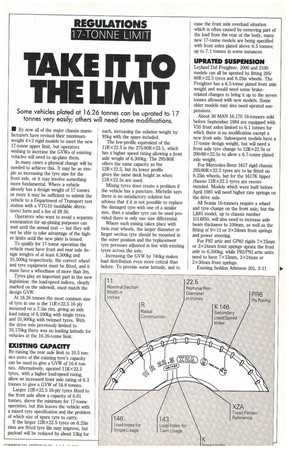TAKE IT TO THE LIMIT
Page 67

If you've noticed an error in this article please click here to report it so we can fix it.
• By now all of the major chassis manufacturers have revised their maximumweight 4x2 rigid models to meet the new 17-tonne upper limit, but operators wishing to increase the GVWs of existing vehicles will need to up-plate them.
In many cases a physical change will be needed to achieve this. It may be as simple as increasing the tyre size for the front axle, or it may involve something more fundamental. Where a vehicle already has a design weight of 17 tonrtes or more it may be sufficient to submit the vehicle to a Department of Transport test station with a VTG10 (notifiable alterations) form and a fee of £9.50.
Operators who want to avoid a separate examination for up-plating purposes can wait until the annual test but they will not be able to take advantage of the higher limits until the new plate is issued.
To qualify for 17-tonne operation the vehicle must have front and rear axle design weights of at least 6,500kg and 10,500kg respectively, the correct wheel and tyre equipment must be fitted, and it must have a wheelbase of more than 3m.
Tyres play an important part in the new legislation: the load/speed indices, clearly marked on the sidewall, must match the design GVW.
At 16.26 tonnes the most common size of tyre in use is the 11R x22.5 16 ply . mounted on a 7.5in rim, giving an axle load rating of 6,100kg with single tyres and 10,900kg with twinned tyres. With the drive axle previously limited to 10,170kg there was no loading latitude for vehicles at the 16.26-tonne limit.
EXISTING CAPACITY
By raising the rear axle limit to 10.5 tonnes more of the existing tyre's capacity can be used to give a GVW of 16.6 tonnes. Alternatively, uprated 11Rx 22.5 tyres, with a higher load/speed rating, allow an increased front axle rating of 6.3 tonnes to give a GVVV of 16.8 tonnes.
Larger 12R x22.5 16-ply tyres fitted to the front axle allow a capacity of 6.61 tonnes, above the minimum for 17-tonne operation, but this leaves the vehicle with a mixed tyre specification and the problem of which size of spare tyre to carry.
If the larger 12R x22.5 tyres on 8.25in rims are fitted tyre life may improve, but payload will be reduced by about 13kg for each, increasing the unladen weight by 91kg with the spare included.
The low-profile equivalent of the 11R x 22.5 is the 275/80R x 22.5, which has a higher speed rating allowing a front axle weight of 6,300kg. The 295/80R offers the same capacity as the 12R x22.5, but its lower profile gives the same deck height as when 11R x22.5s are used.
Mixing tyres does create a problem if the vehicle has a puncture. Michelin says there is no satisfactory solution but advises that if it is not possible to replace the damaged tyre with one of a similar size, then a smaller tyre can be used provided there is only one size differential.
Where such mixing takes place with twin rear wheels, the larger diameter or larger section tyre should be mounted in the outer position and the replacement tyre pressure adjusted in line with existing tyres across the axle.
Increasing the GVW by 740kg makes load distribution even more critical than before. To provide some latitude, and to ease the front axle overload situation which is often caused by removing part of the load from the rear of the body, many new 17-tonne models are being specified with front axles plated above 6.5 tonnes; up to 7.1 tonnes in some instances.
UPRATED SUSPENSION
Leyland Daf Freighter, 2000 and 2100 models can all be uprated by fitting 295/ 80R x22.5 tyres and 8.25in wheels. The Freighter has a 6.5-tonne plated front axle weight and would need some brakerelated changes to bring it up to the seven tonnes allowed with new models. Some older models may also need uprated suspensions.
About 30 MAN 16.170 16-tonners sold before September 1984 are equipped with V55 front axles limited to 6.1 tonnes for which there is no modification except a new front axle. Subsequent models have a 17-tonne design weight, but will need a front axle tyre change to 12R x22.5s or 290/80 x 22.5s to allow a 6.7-tonne plated axle weight.
For Mercedes-Benz 1617 rigid chassis 295/80R x22.5 tyres are to be fitted on 8.25in wheels, but for the 1617K tipper chassis 12R x22.5 tyres are recommended. Models which were built before April 1985 will need higher rate springs on the drive axle.
All Scania 16-tonners require a wheel and tyre change on the front axle, but the LB81 model, up to chassis number 1014850, will also need to increase axle beam thickness to 100mm, as well as the fitting of 9x13 or 3x24rrun front springs and power steering.
For P82 artic and GP82 rigids 7x15mm or 3x 24mm front springs uprate the front axle to 6,500kg, while P82/P92 artic units need to have 7x15nun, 3x24nun or 2 x 30rnm front springs.
Existing Seddon Atkinson 201, 2-11
















































































































































